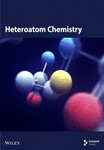Hydrogen bonding networks in [(η6-arene)Cr(CO)3] complexes†
Dedicated to Professor Kin-ya Akiba on the occasion of his 75th birthday.
Abstract
The four different [(η6-arene)chromium tricarbonyl] complexes [(η6-C6H5CH2COOH) Cr(CO)3], [{η6-(1,2-C6H4(NH2)COOEt)}Cr(CO)3], [η6 -{2,6-C6H4(i-Pr)2NH2}Cr(CO)3], and [{η6 -(1,4-C6H4(NH2)CH3)}Cr(CO)3] were synthesized and structurally characterized by single crystal X-ray diffraction. All compounds form hydrogen bonds in the solid state, leading to dimeric or polymeric networks. The hydrogen bonds are an essential part of the network. The connectivity is influenced by the groups on which the protons are bound (COOH vs. NH2) and by the steric demand of the ligand. © 2011 Wiley Periodicals, Inc. Heteroatom Chem 22:294–300, 2011; View this article online at wileyonlinelibrary.com. DOI 10.1002/hc.20679




